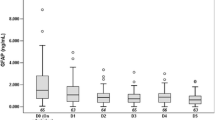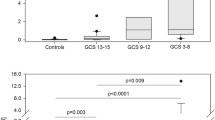Abstract
Objectives
Over the years, blood biomarkers have been extensively applied for diagnostic and prognostic assessment of traumatic brain injury (TBI). Herein, we conducted a meta-analysis to evaluate the diagnostic and prognostic value of glial fibrillary acidic protein (GFAP) for TBI patients.
Methods
The online databases, including PubMed, Embase, Cochrane Library, CNKI, and WFSD, were systematically retrieved from inception until May 2021. The RevMan 5.3 software and Stata 15 were used to conduct data analysis.
Results
A total of 22 eligible studies comprising 3709 patients were included in this meta-analysis. The pooled results indicated that serum GFAP had a diagnostic value in detecting traumatic intracranial lesions (AUC 0.81; 95% CI 0.77–0.84; p < 0.00001). The pooled sensitivity and specificity were 0.93 (95% CI 0.81–0.98), and 0.66 (95% 0.53–0.77; p < 0.00001), respectively. For assessment of unfavorable outcome, the pooled sensitivity, specificity and AUC value were 0.66 (95% CI 0.54–0.76; p < 0.00001), 0.82(95% CI 0.72–0.90; p < 0.00001), and 0.82 (95% CI 0.76–0.88; p < 0.00001), respectively. Besides, GFAP exhibited a significant value in predicting mortality (AUC 0.81; 95% CI 0.77–0.84; p < 0.00001), with high sensitivity and specificity (0.86, 95% CI 0.79–0.92, p < 0.00001, and 0.66, 95% CI 0.52–0.77, p < 0.00001). The subgroup analysis indicated that the type of TBI and cut-off value were potential sources of heterogeneity, which influenced the pooled AUC values for mortality prediction.
Conclusions
Our meta-analysis indicated that GFAP had diagnostic and prognostic value for TBI patients, especially during the early TBI.







Similar content being viewed by others
References
Taylor CA, Bell JM, Breiding MJ, Xu L. Traumatic brain injury-related emergency department visits, hospitalizations, and deaths—United States, 2007 and 2013. MMWR Surveill Summ. 2017;66(9):1–16.
Papa L, Brophy GM, Welch RD, Lewis LM, Braga CF, Tan CN, et al. Time course and diagnostic accuracy of glial and neuronal blood biomarkers GFAP and UCH-L1 in a large cohort of trauma patients with and without mild traumatic brain injury. JAMA Neurol. 2016;73(5):551–60. https://doi.org/10.1001/jamaneurol.2016.0039.
Naalt JVD, Hew JM, Zomeren AHV, Sluiter WJ, Minderhoud JM. Computed tomography and magnetic resonance imaging in mild to moderate head injury: early and late imaging related to outcome. Ann Neurol. 1999;46(1):70–8.
Eng LF, Vanderhaeghen JJ, Bignami A, Gerstl B. An acidic protein isolated from fibrous astrocytes. Brain Res. 1971;28(2):351–4.
Papa L, Zonfrillo MR, Ramirez J, Silvestri S, Giordano P, Braga CF, et al. Performance of glial fibrillary acidic protein detecting traumatic intracranial lesions on computed tomography in children and youth with mild head trauma. Acad Emerg Med. 2015;22(11):1274–82. https://doi.org/10.1111/acem.12795.
Posti JP, Takala RSK, Lagerstedt L, Dickens AM, Hossain I, Mohammadian M, et al. Correlation of blood biomarkers and biomarker panels with traumatic findings on computed tomography after traumatic brain injury. J Neurotrauma. 2019;36(14):2178–89. https://doi.org/10.1089/neu.2018.6254 (Epub 2019 Apr 5).
Pelinka LE, Kroepfl A, Leixnering M, Buchinger W, Raabe A, Redl H. GFAP versus S100B in serum after traumatic brain injury: relationship to brain damage and outcome. J Neurotrauma. 2004;21(11):1553–61. https://doi.org/10.1089/neu.2004.21.1553.
Kumar A, Misra S, Yadav AK, Sagar R, Verma B, Grover A, et al. Role of glial fibrillary acidic protein as a biomarker in differentiating intracerebral haemorrhage from ischaemic stroke and stroke mimics: a meta-analysis. Biomarkers. 2020;25(1):1–8.
Sun Y, Qin Q, Shang Y-J, Fang C-P, Zhang W-W, Gu M-L, et al. The accuracy of glial fibrillary acidic protein in acute stroke differential diagnosis: a meta-analysis. Scand J Clin Lab Invest. 2013;73(8):601–6.
Perry LA, Lucarelli T, Penny-Dimri JC, McInnes MD, Mondello S, Bustamante A, et al. Glial fibrillary acidic protein for the early diagnosis of intracerebral hemorrhage: systematic review and meta-analysis of diagnostic test accuracy. Int J Stroke. 2019;14(4):390–9.
Shemilt M, Boutin A, Lauzier F, Zarychanski R, Moore L, McIntyre LA, et al. Prognostic value of glial fibrillary acidic protein in patients with moderate and severe traumatic brain injury: a systematic review and meta-analysis. Crit Care Med. 2019;47(6):e522–9.
Liberati A, Altman DG, Tetzlaff J, Mulrow C, Gøtzsche PC, Ioannidis JPA, et al. The PRISMA statement for reporting systematic reviews and meta-analyses of studies that evaluate health care interventions: explanation and elaboration. PLoS Med. 2009;6(7): e1000100. https://doi.org/10.1371/journal.pmed.1000100.
Whiting PF, Rutjes AWS, Westwood ME, Mallett S, Deeks JJ, Reitsma JB, et al. QUADAS-2: a revised tool for the quality assessment of diagnostic accuracy studies. Ann Intern Med. 2011;155(8):529–36.
Zhao Y, Li L, Wang Y, Liu J. Relationship between serum levels of GFAP BDPs, UCH-L1, NSE and prognosis in patients with mild craniocerebral injury correlation of prognosis. Chin J Gerontol. 2018;38:3077–80. https://doi.org/10.3969/j.issn.1005-9202.2018.13.002.
Zhang Y, Zhang M. The relationship between serum biomarker GFAP and CT manifestations in patients with mild craniocerebral injury and its clinical significance. Smart Healthcare. 2020;6(2):46–7. https://doi.org/10.19335/j.cnki.2096-1219.2020.02.019.
Xue L, Rao R, Ge L, Huang X, Chen J. The relationship between mild traumatic brain injury ( mTBI) and serum glial fibrillary acidic protein breakdown products ( GFAP-BDPs ) change. Surg Res New Tech. 2014;3(1):24–7.
Shao L, Chen Y, Zheng L, Cheng Z, Yu J. Change and clinical significance of serum GFAP in patients with traumatic brain injury. Clin Educ General Pract. 2011;9(3):255–7.
Rica RDL, Borges M, Aranda M, Castillo AD, Socias A, Payeras A, et al. Low albumin levels are associated with poorer outcomes in a case series of COVID-19 patients in Spain: a retrospective cohort study. Microorganisms. 2020;8(8):1106.
Lei J, Gao G, Feng J, Jin Y, Wang C, Mao Q, et al. Glial fibrillary acidic protein as a biomarker in severe traumatic brain injury patients: a prospective cohort study. Crit Care. 2015;12:19362. https://doi.org/10.1186/s13054-015-1081-8.
Guo Z, Zhang H, Wei X, Xiang L, Zhang Y, Zhao Z, et al. Correlation of serum GFAP, NSE and national institute of health stroke scale in patients with traumatic brain injury. Chin J Neurotrauma Surg (Electronic Edition). 2018;4(6):333–6.
Papa L, Silvestri S, Brophy GM, Giordano P, Falk JL, Brag CF, et al. GFAP out-performs S100β in detecting traumatic intracranial lesions on computed tomography in trauma patients with mild traumatic brain injury and those with extracranial lesions. J Neurotrauma. 2014;31(22):1815–22. https://doi.org/10.1089/neu.2013.3245.
Lumpkins KM, Bochicchio GV, Keledjian K, Simard JM, McCunn M, Scalea T. Glial fibrillary acidic protein is highly correlated with brain injury. J Trauma. 2008;65(4):778–82. https://doi.org/10.1097/TA.0b013e318185db2d.
Lagerstedt L, Egea-Guerrero JJ, Bustamante A, Rodríguez-Rodríguez A, Rahal AE, Quintana-Diaz M, et al. Combining H-FABP and GFAP increases the capacity to differentiate between CT-positive and CT-negative patients with mild traumatic brain injury. PLoS One. 2018;13(7): e0200394. https://doi.org/10.1371/journal.pone.0200394.
Gill J, Latour L, Diaz-Arrastia R, Motamedi V, Turtzo C, Shahim P, et al. Glial fibrillary acidic protein elevations relate to neuroimaging abnormalities after mild TBI. Neurology. 2018;91(15):e1385–9. https://doi.org/10.1212/wnl.0000000000006321.
Gardner RC, Rubenstein R, Wang KKW, Korley FK, Yue JK, Yuh EL, et al. Age-related differences in diagnostic accuracy of plasma glial fibrillary acidic protein and tau for identifying acute intracranial trauma on computed tomography: a TRACK-TBI study. J Neurotrauma. 2018;35(20):2341–5. https://doi.org/10.1089/neu.2018.5694.
Bazarian JJ, Biberthaler P, Welch RD, Lewis LM, Barzo P, Bogner-Flatz V, et al. Serum GFAP and UCH-L1 for prediction of absence of intracranial injuries on head CT (ALERT-TBI): a multicentre observational study. Lancent Neurol. 2018;17(9):782–9. https://doi.org/10.1016/S1474-4422(18)30231-X.
Vos PE, Lamers KJB, Hendriks JCM, Haaren MV, Beems T, Zimmerman C, et al. Glial and neuronal proteins in serum predict outcome after severe traumatic brain injury. Neurology. 2004;62(8):1303–10. https://doi.org/10.1212/01.wnl.0000120550.00643.dc.
Vos PE, Jacobs B, Andriessen TMJC, Lamers KJB, Borm GF, Beems T, et al. GFAP and S100B are biomarkers of traumatic brain injury: an observational cohort study. Neurology. 2010;75(20):1786–93. https://doi.org/10.1212/WNL.0b013e3181fd62d2.
Posti JP, Takala RSK, Runtti H, Newcombe VF, Outtrim J, Katila AJ, et al. The levels of glial fibrillary acidic protein and ubiquitin C-terminal hydrolase-L1 during the first week after a traumatic brain injury: correlations with clinical and imaging findings. Neurosurgery. 2016;79(3):456–64. https://doi.org/10.1227/NEU.0000000000001226.
Nylén K, Ost M, Csajbok LZ, Nilsson I, Blennow K, Nellgård B, et al. Increased serum-GFAP in patients with severe traumatic brain injury is related to outcome. J Neurol Sci. 2006;240(1–2):85–91. https://doi.org/10.1016/j.jns.2005.09.007.
Metting Z, Wilczak N, Rodiger LA, Schaaf JM, Naalt JVD. GFAP and S100B in the acute phase of mild traumatic brain injury. Neurology. 2012;78(18):1428–33. https://doi.org/10.1212/WNL.0b013e318253d5c7.
Kumar A, Misra S, Yadav AK, Sagar R, Verma B, Grover A, et al. Role of glial fibrillary acidic protein as a biomarker in differentiating intracerebral haemorrhage from ischaemic stroke and stroke mimics: a meta-analysi. Biomarkers. 2020;25(1):1–8.
Hol EM, Pekny M. Glial fibrillary acidic protein (GFAP) and the astrocyte intermediate filament system in diseases of the central nervous system. Curr Opin Cell Biol. 2015;32:121–30.
Wang KK, Yang Z, Zhu T, Shi Y, Rubenstein R, Tyndall JA, et al. An update on diagnostic and prognostic biomarkers for traumatic brain injury. Expert Rev Mol Diagn. 2018;18(2):165–80.
Styrke J, Stålnacke B-M, Sojka P, Björnstig U. Traumatic brain injuries in a well-defined population: epidemiological aspects and severity. J Neurotrauma. 2007;24(9):1425–36.
Stiell IG, Wells GA, Vandemheen K, Clement C, Lesiuk H, Laupacis A, et al. The Canadian CT Head Rule for patients with minor head injury. Lancent. 2001;357(9266):1391–6.
Acknowledgements
The authors would like to thank the “European Journal of Trauma and Emergency Surgery” for providing such an excellent academic platform.
Funding
This study was supported by the Hospital Level Support Projects (Fcjs202050); the Jiangsu Key Laboratory of Experimental & Translational Non-coding RNA Research (201902).
Author information
Authors and Affiliations
Corresponding author
Ethics declarations
Conflict of interest
None declared.
Ethical approval
Not applicable.
Supplementary Information
Below is the link to the electronic supplementary material.
68_2022_1979_MOESM2_ESM.tif
Supplementary file2 (TIF 106 kb) The funnel plot of DEEK`s funnel plot for pooled sensitivity and specificity in detecting traumatic intracranial lesions, assessing unfavorable outcome, and predicting mortality (a, b, and c); funnel plot for pooled AUC value in detecting traumatic intracranial lesions, assessing unfavorable outcome, and predicting mortality (d, e, and f)
Rights and permissions
About this article
Cite this article
Pei, Y., Tang, X., Zhang, E. et al. The diagnostic and prognostic value of glial fibrillary acidic protein in traumatic brain injury: a systematic review and meta-analysis. Eur J Trauma Emerg Surg 49, 1235–1246 (2023). https://doi.org/10.1007/s00068-022-01979-y
Received:
Accepted:
Published:
Issue Date:
DOI: https://doi.org/10.1007/s00068-022-01979-y




